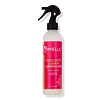What's inside
What's inside
 Key Ingredients
Key Ingredients

 Benefits
Benefits

 Concerns
Concerns

 Ingredients Side-by-side
Ingredients Side-by-side

Water
Skin ConditioningCamellia Sinensis Extract
AntioxidantCocos Nucifera Oil
MaskingCetyl Alcohol
EmollientCetearyl Alcohol
EmollientStearalkonium Chloride
PreservativeSimmondsia Chinensis Seed Oil
EmollientOlea Europaea Fruit Oil
MaskingGlycerin
HumectantDelta-Decalactone
MaskingArgania Spinosa Kernel Oil
EmollientMentha Piperita Leaf Extract
Skin ConditioningYucca Schidigera Root Extract
Skin ConditioningEquisetum Arvense Leaf Extract
AstringentUrtica Dioica Leaf Extract
Skin ConditioningMelissa Officinalis Leaf Extract
Skin ConditioningHydrolyzed Silk
HumectantPotassium Sorbate
PreservativeDiethyl Phthalate
MaskingCitrus Grandis Seed Extract
AstringentCyamopsis Tetragonoloba Gum
Emulsion StabilisingCitric Acid
BufferingWater, Camellia Sinensis Extract, Cocos Nucifera Oil, Cetyl Alcohol, Cetearyl Alcohol, Stearalkonium Chloride, Simmondsia Chinensis Seed Oil, Olea Europaea Fruit Oil, Glycerin, Delta-Decalactone, Argania Spinosa Kernel Oil, Mentha Piperita Leaf Extract, Yucca Schidigera Root Extract, Equisetum Arvense Leaf Extract, Urtica Dioica Leaf Extract, Melissa Officinalis Leaf Extract, Hydrolyzed Silk, Potassium Sorbate, Diethyl Phthalate, Citrus Grandis Seed Extract, Cyamopsis Tetragonoloba Gum, Citric Acid
Water
Skin ConditioningCetearyl Alcohol
EmollientBehentrimonium Methosulfate
Cetyl Esters
EmollientAmodimethicone
Argania Spinosa Kernel Oil
EmollientParfum
MaskingPhenoxyethanol
PreservativeCitric Acid
BufferingBehentrimonium Chloride
PreservativeTrideceth-6
EmulsifyingIsopropyl Alcohol
SolventCetrimonium Chloride
AntimicrobialSodium Hyaluronate
HumectantBenzyl Alcohol
PerfumingLinalool
PerfumingCoumarin
PerfumingLimonene
PerfumingHexyl Cinnamal
PerfumingCitronellol
PerfumingBenzyl Benzoate
AntimicrobialAmyl Cinnamal
PerfumingCitral
PerfumingGeraniol
PerfumingWater, Cetearyl Alcohol, Behentrimonium Methosulfate, Cetyl Esters, Amodimethicone, Argania Spinosa Kernel Oil, Parfum, Phenoxyethanol, Citric Acid, Behentrimonium Chloride, Trideceth-6, Isopropyl Alcohol, Cetrimonium Chloride, Sodium Hyaluronate, Benzyl Alcohol, Linalool, Coumarin, Limonene, Hexyl Cinnamal, Citronellol, Benzyl Benzoate, Amyl Cinnamal, Citral, Geraniol
Ingredients Explained
These ingredients are found in both products.
Ingredients higher up in an ingredient list are typically present in a larger amount.
You may know this ingredient as argan oil. Argan Oil has antioxidant, hydrating, and soothing properties.
Studies have shown argan oil can help fight again radical damage from the sun. This makes it effective at preventing hyperpigmentation.
Large amounts of vitamin E found in argan oil helps the skin retain water. Argan oil also contains fatty acids such as linoleic acid, oleic acid, and palmitic acid. It is also a good source of lipids.
Another benefit of argan oil is skin-soothing. It can help reduce inflammation-related skin symptoms.
Argan Oil is effective at regulating sebum production in pores. This can make it effective at treating hormonal acne.
Traditionally, argan oil was used for its antibacterial and antifungal properties. However, argan oil contains fatty acids that may make it not fungal-acne safe.
Argan Trees are native to Morocco.
Learn more about Argania Spinosa Kernel OilCetearyl alcohol is a mixture of two fatty alcohols: cetyl alcohol and stearyl alcohol. It is mainly used as an emulsifier. Emulsifiers help prevent the separation of oils and products. Due to its composition, it can also be used to thicken a product or help create foam.
Cetearyl alcohol is an emollient. Emollients help soothe and hydrate the skin by trapping moisture.
Studies show Cetearyl alcohol is non-toxic and non-irritating. The FDA allows products labeled "alcohol-free" to have fatty alcohols.
This ingredient is usually derived from plant oils such as palm, vegetable, or coconut oils. There is debate on whether this ingredient will cause acne.
Due to the fatty acid base, this ingredient may not be Malassezia folliculitis safe.
Learn more about Cetearyl AlcoholCitric Acid is an alpha hydroxy acid (AHA) naturally found in citrus fruits like oranges, lemons, and limes.
Like other AHAs, citric acid can exfoliate skin by breaking down the bonds that hold dead skin cells together. This helps reveal smoother and brighter skin underneath.
However, this exfoliating effect only happens at high concentrations (20%) which can be hard to find in cosmetic products.
Due to this, citric acid is usually included in small amounts as a pH adjuster. This helps keep products slightly more acidic and compatible with skin's natural pH.
In skincare formulas, citric acid can:
While it can provide some skin benefits, research shows lactic acid and glycolic acid are generally more effective and less irritating exfoliants.
Most citric acid used in skincare today is made by fermenting sugars (usually from molasses). This synthetic version is identical to the natural citrus form but easier to stabilize and use in formulations.
Read more about some other popular AHA's here:
Learn more about Citric AcidWater. It's the most common cosmetic ingredient of all. You'll usually see it at the top of ingredient lists, meaning that it makes up the largest part of the product.
So why is it so popular? Water most often acts as a solvent - this means that it helps dissolve other ingredients into the formulation.
You'll also recognize water as that liquid we all need to stay alive. If you see this, drink a glass of water. Stay hydrated!
Learn more about Water